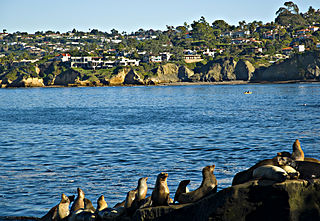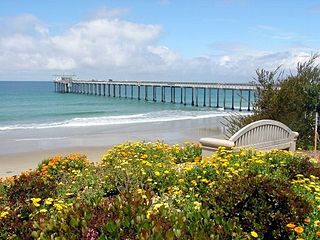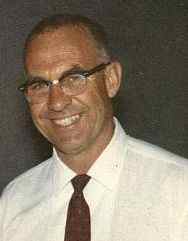
The University of California, San Diego is a public land-grant research university in San Diego, California, United States. Established in 1960 near the pre-existing Scripps Institution of Oceanography, UC San Diego is the southernmost of the ten campuses of the University of California, and offers over 200 undergraduate and graduate degree programs, enrolling 33,096 undergraduate and 9,872 graduate students. The university occupies 2,178 acres (881 ha) near the coast of the Pacific Ocean, with the main campus resting on approximately 1,152 acres (466 ha).

La Jolla is a hilly, seaside neighborhood within the city of San Diego, occupying 7 miles (11 km) of curving coastline along the Pacific Ocean. The population reported in the 2010 census was 46,781. The climate is mild, with an average daily temperature of 70.5 °F (21.4 °C).

The Scripps Institution of Oceanography (SIO) is the center for oceanography and Earth science based at the University of California, San Diego. Its main campus is located in La Jolla, with additional facilities in Point Loma.

Shedd Aquarium is an indoor public aquarium in Chicago. Opened on May 30, 1930, the 5 million US gal aquarium holds about 32,000 animals and is the third largest aquarium in the Western Hemisphere, after the Georgia Aquarium and Monterey Bay Aquarium.

The leafy seadragon or Glauert's seadragon, is a marine fish. It is the only member of the genus Phycodurus in the family Syngnathidae, which includes seadragons, pipefish, and seahorses.

The New England Aquarium is a nonprofit organization located in Boston, Massachusetts. The species exhibited include harbor and northern fur seals, California sea lions, African and southern rockhopper penguins, giant Pacific octopuses, weedy seadragons, and thousands of saltwater and freshwater fishes. In addition to the main aquarium building, attractions at Central Wharf include the Simons Theatre and the New England Aquarium Whale Watch. More than 1.3 million guests visited the aquarium each year prior to the outbreak of the COVID-19 pandemic.

Black's Beach is a secluded section of beach beneath the bluffs of Torrey Pines on the Pacific Ocean in La Jolla, San Diego, California, United States. It is officially part of Torrey Pines State Beach. The northern portion of Black's Beach is owned and managed by the California Department of Parks and Recreation, while the southern portion of the beach, officially known as Torrey Pines City Beach, is jointly owned by the city of San Diego and the state park, but is managed by the city of San Diego. This distinction is important as Black's Beach is most known as a nude beach, a practice that is now prohibited in the southern portion managed by the city of San Diego.

The common seadragon or weedy seadragon is a marine fish of the order Syngnathiformes, which also includes the similar pipefishes, seahorses, and trumpetfishes among other species. Adult common seadragons are a reddish colour, with yellow and purple striped markings; they have small, leaf-like appendages that resemble kelp or seaweed fronds, providing camouflage, as well as a number of short spines for protection. As with seahorses and the other syngnathids, the seadragon has a similarly tubular snout and a fused, toothless jaw into which it captures small invertebrate prey at lightning speed. Males have narrower bodies and are darker than females. Seadragons have a long dorsal fin along the back and small pectoral fins on either side of the neck, which provide balance. Weedy seadragons can reach 45 cm (18 in) in length.

KGTV is a television station in San Diego, California, United States, affiliated with ABC and owned by the E. W. Scripps Company. The station's studios are located on Air Way in the Riverview-Webster section of San Diego, and its transmitter is located on Mount Soledad in La Jolla.
John Robert Beyster, often styled J. Robert Beyster, was an American scientist and entrepreneur, and the founder of Science Applications International Corporation. He was Chairman of the Board until his retirement in July 2004, and served as chief executive officer (CEO) until November 2003. Beyster's primary areas of interest were national security and nuclear reactor physics. Beyster also founded two nonprofit organizations to assist organizations considering employee ownership: the Beyster Institute and the Foundation for Enterprise Development.

Ellen Browning Scripps was an American journalist and philanthropist who was the founding donor of several major institutions in Southern California. She and her half-brother E.W. Scripps created the E.W. Scripps Company, America's largest chain of newspapers, linking Midwestern industrial cities with booming towns in the West. By the 1920s, Ellen Browning Scripps was worth an estimated $30 million, most of which she gave away.

The University of California, San Diego School of Medicine is the graduate medical school of the University of California, San Diego, a public land-grant research university in La Jolla, California. It was the third medical school in the University of California system, after those established at UCSF and UCLA, and is the only medical school in the San Diego metropolitan area. It is closely affiliated with the medical centers that are part of UC San Diego Health.

USS Snatch (ARS-27), well known as Scripps RV Argo after conversion to scientific research, was a Diver-class rescue and salvage ship commissioned by the U.S. Navy during World War II and in service from 11 December 1944 through 23 December 1946. Her task was to come to the aid of stricken vessels. The ship is better known from her scientific research role as the Scripps Institution of Oceanography (SIO) research vessel RV Argo. It is that name, apparently not formally recognized by Navy that maintained title to the vessel, found in the scientific literature and public releases about her wide ranging research voyages.

The Old Scripps Building is a historic research facility on the campus of the University of California, San Diego in La Jolla, California. Built in 1909-10, it is the oldest oceanographic research building in continuous use in the United States and the historic center of the Scripps Institution of Oceanography. It is also architecturally significant as a work of Modernist architect Irving Gill and for its early use of reinforced concrete. It was declared a National Historic Landmark in 1982. It now houses Scripps administrative offices.

San Diego-Scripps Coastal Marine Conservation Area (SMCA) and Matlahuayl State Marine Reserve (SMR) are adjoining marine protected areas that extend offshore from La Jolla in San Diego County on California's south coast. The two marine protected areas cover 2.51 square miles (6.5 km2).
South La Jolla State Marine Conservation Area (SMCA) and South La Jolla State Marine Reserve (SMR) are two adjoining marine protected areas that extend offshore in San Diego County on California's south coast. The two marine protected areas cover 7.51 square miles (19.5 km2). The SMR protects marine life by prohibiting the removal of marine wildlife from within its borders, while the SMCA limits removal of marine wildlife.

The Greater Cleveland Aquarium is an aquarium in Cleveland, Ohio. Occupying the historic FirstEnergy Powerhouse building located on the west bank of the Cuyahoga River in the city's Flats district, the aquarium, which opened in January 2012, consists of approximately 70,000 square feet (6,500 m2) of exhibition space and features 55 exhibits over 9 thematic concentrations representing both local and exotic species of fish. The facility is the only independent, free-standing aquarium in the state of Ohio and ended a 26-year period that the city lacked a public aquarium.

Frank Edwin Snodgrass was a physical oceanographer and electrical engineer. He spent nearly all of his career working with Prof. Walter Munk at Scripps Institution of Oceanography (SIO). The Cecil H. and Ida M. Green branch of the University of California Systemwide Institute of Geophysics and Planetary Physics (IGPP), in La Jolla, California has been strongly linked to Scripps since the 1960s through joint faculty appointments, research interests, and shared facilities. Other IGPP branches can be found at the Los Angeles, Irvine, Santa Cruz and Riverside campuses. Snodgrass spent many years researching and measuring the ocean tides and waves. During his career he had opportunities to work with fellow scientists around the world, including collaborations through the IGPP campuses, with Woods Hole Oceanographic Institution in Massachusetts and with the National Institute of Oceanography in England.

Judith Munk was an American artist and designer associated with Scripps Institution of Oceanography. She was inducted into the San Diego Women's Hall of Fame posthumously, in 2008.

Andreas Buchwald Rechnitzer was an American oceanographer. With Carl Hubbs, he discovered the striped yellow butterfly fish that served as the logo of the Birch Aquarium. He helped develop the first SCUBA diving training program for ocean scientists, which included such innovations as ditch-and-don, buddy breathing, and the buddy system. He was a member of the US Navy Office of Naval Research team that negotiated the purchase of the bathyscape Trieste, and was the scientist in charge of Project Nekton in 1960, during which the Trieste entered the Challenger Deep, the deepest surveyed point in the world's oceans. For this he received the Navy Distinguished Civilian Service Award. He joined the scientific staff of the Chief of Naval Operations, where he was the Oceanographer of the Navy from 1970 to 1984, and was the Senior Scientist at Science Applications International Corporation from 1985 to 1998.


























